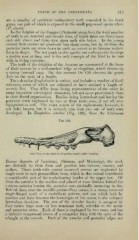Page 405 - My FlipBook
P. 405
TEETH OF THE VERTEBRATA. 415
are a number of persistent rudimentary teeth concealed in the thick
gums, one pair of which is exposed in the small pug-nosed sperm whale
(P. simus).
In the dolphin of the Ganges (Platynista gangetica) the total number
of teeth is one hundred and twenty-four, of which there are thirty upon
each side above and thirty-two upon each side below. In the young
animal their crowns are produced into sharp cones, but by attrition the
posterior teeth are worn down to such an extent as to become molari-
ibrm in shape. The last tooth in this species not unfrequently develops
a double root or fang, and is the only example of the kind to be met
with in living cetaceans.
The teeth of the dolphins of the Amazon are surrounded at the bases
of their crowns by a well-marked ledge or cingulum, which throws up
a strong internal cusp. On this account Dr. Gill elevates the genus
Inia to the rank of a family.
The sub-order Zeuglodontla is extinct, and includes a number of fossil
cetaceans, some of which are estimated to have attained a length of
seventy feet. They differ from living representatives of the order in
many important osteological characters, but not more prominently than
in their dental organization. Besides being heterodont and having the
])osterior teeth implanted by two or three roots, some, if not all, were
diphyodont as ivell. The exact extent of the replacement, however, is
not fully known, but it is certainly true that two sets of teeth were
developed. In Zeuglodon cetoldes (Fig. 199), from the Claiborne
Fig. 199.
Side View of the Skull of Zi-uytudon celoides (after Gaudry).
Eocene deposits of Louisiana, Alabama, and Mississippi, the teeth
are divisible by their form and position into incisors, canines, and
molars. Three teeth with conical recurved crowns are implanted by
single roots in each premaxillary bone, which in this animal contributes
a considerable part of the tooth-bearing border of the upper jaw. Of
these the anterior is the smallest and placed at some distance behind the
extreme anterior border, the posterior ones gradually increasing in size.
Behind these, near the maxillo-jiremaxillary suture, is a strong recurved
single-fanged tooth of a caniniform pattern, and one which both by
position and form becomes the homologue of the canine in the ordinary
heterodont dentition. The rest of the alveolar border is occupied by
four rather large more or less trenchant teeth, referable to the molar
and premolar series. Each of these is implanted by two roots, and has
a laterally compressed crown of a triangular form with the apex of the
triangle at the summit. Each of the anterior and posterior edges are


